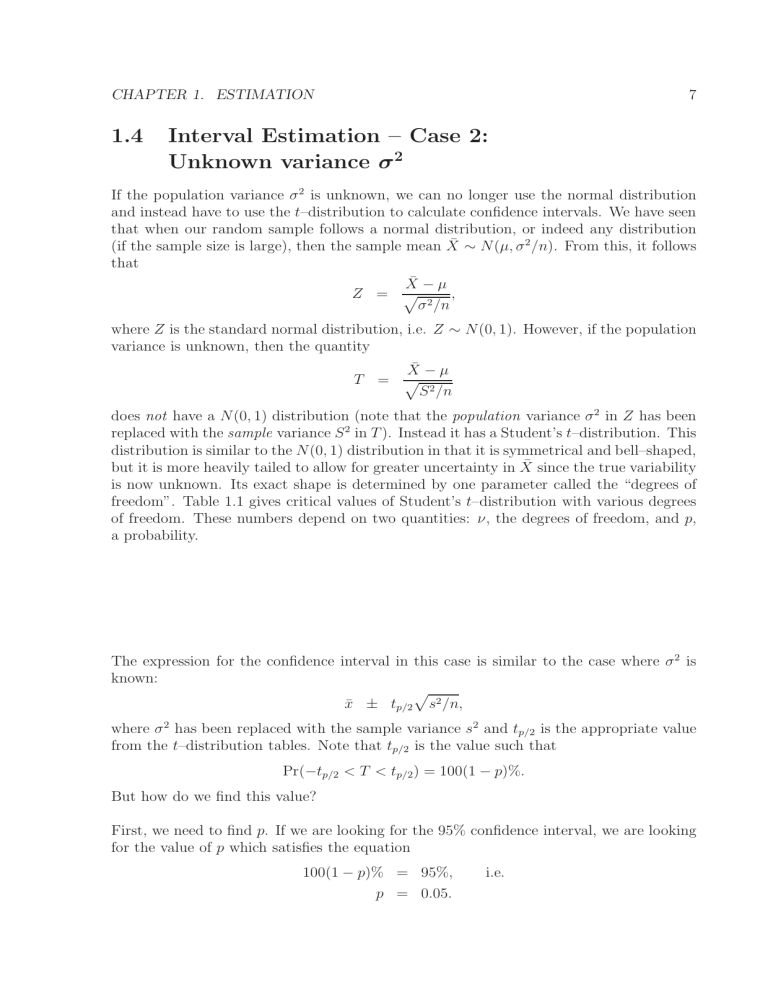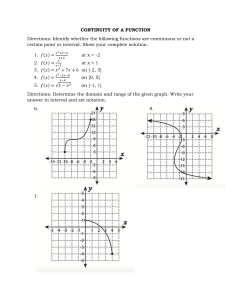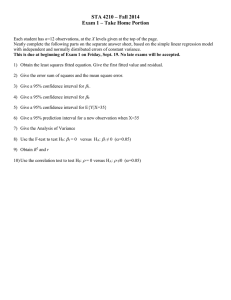
7 CHAPTER 1. ESTIMATION 1.4 Interval Estimation – Case 2: Unknown variance σ 2 If the population variance σ 2 is unknown, we can no longer use the normal distribution and instead have to use the t–distribution to calculate confidence intervals. We have seen that when our random sample follows a normal distribution, or indeed any distribution (if the sample size is large), then the sample mean X̄ ∼ N(µ, σ 2 /n). From this, it follows that X̄ − µ Z = p , σ 2 /n where Z is the standard normal distribution, i.e. Z ∼ N(0, 1). However, if the population variance is unknown, then the quantity X̄ − µ T = p S 2 /n does not have a N(0, 1) distribution (note that the population variance σ 2 in Z has been replaced with the sample variance S 2 in T ). Instead it has a Student’s t–distribution. This distribution is similar to the N(0, 1) distribution in that it is symmetrical and bell–shaped, but it is more heavily tailed to allow for greater uncertainty in X̄ since the true variability is now unknown. Its exact shape is determined by one parameter called the “degrees of freedom”. Table 1.1 gives critical values of Student’s t–distribution with various degrees of freedom. These numbers depend on two quantities: ν, the degrees of freedom, and p, a probability. The expression for the confidence interval in this case is similar to the case where σ 2 is known: p x̄ ± tp/2 s2 /n, where σ 2 has been replaced with the sample variance s2 and tp/2 is the appropriate value from the t–distribution tables. Note that tp/2 is the value such that Pr(−tp/2 < T < tp/2 ) = 100(1 − p)%. But how do we find this value? First, we need to find p. If we are looking for the 95% confidence interval, we are looking for the value of p which satisfies the equation 100(1 − p)% = 95%, p = 0.05. i.e. 8 CHAPTER 1. ESTIMATION We would look up the value in the t tables (table 1.1) in the p column, or in this case the 5% column. We also need to know which row to look in. The rows are given as the degrees of freedom, ν, where ν = n − 1. Hence, if our sample was of size n = 10 and we were looking for the 95% confidence interval, we would look in the ν = 9 row and the p = 5% column to give us a value of 2.262 to use in our calculation. Example A sample of size 15 is taken from a larger population; the sample mean is calculated as 12 and the sample variance as 25. What is the 95% confidence interval for the population mean µ? We know that the confidence interval is given by p x̄ ± tp/2 s2 /n, where n ν p x̄ s2 = = = = = 15, n − 1 = 15 − 1 = 14, 5%, 12 and 25. We can find our t value by looking in the p = 5% column and the ν = 14 row, giving a value of 2.145. Putting what we know into our expression, we get r 25 12 ± t2.5% 15 r 25 i.e. 12 ± 2.145 15 12 ± 2.77. Hence, the confidence interval is (9.23, 14.77). 9 CHAPTER 1. ESTIMATION 1.4.1 Application of Confidence Intervals You might be asking: “why do we bother calculating confidence intervals?”. Firstly, by calculating a confidence interval for the population mean, it allows us to see how confident we are of the point estimate we have calculated. The wider the range, the less precise we can be about the population value. Secondly, it allows us to start looking at differences between groups. If the confidence intervals for two samples do not overlap, this could suggest that they are from separate populations. Or if we have a known value for a population and this does not fall within the confidence interval of our sample, this could suggest that there is something different about this sample. For example, if the average daily taking for all shops in a chain was £12550, and we calculated the confidence interval for the population mean of one particular branch as (£11000, £11500), we can say that this branch is out of line with the company as a whole, and it appears that its daily takings are lower. Example A credit card company wants to determine the mean income of its card holders. It also wants to find out if there are any differences in mean income between males and females. A random sample of 225 male card holders and 190 female card holders was drawn, and the following results obtained: Mean Standard deviation Males £16 450 £3675 Females £13 220 £3050 Calculate 95% confidence intervals for the mean income for males and females. Is there any evidence to suggest that, on average, males’ and females’ incomes differ? If so, describe this difference. 95% confidence interval for male income The true population variance, σ 2 , is unknown, so we can’t use the approach of section 1.3. Instead, we follow that of section 1.4 which uses the t–distribution, i.e. p x̄ ± tp/2 × s2 /n. Here, x̄ = 16450, s2 = 36752 = 13505625 n = 225. and The value tp/2 must be found from table 1.1. Recall that the degrees of freedom, ν = n−1, and so here we have ν = 225 − 1 = 224. Notice that table 1.1 only gives value of ν up to 29; for higher values, we use the ∞ row. Since we require a 95% confidence interval, 10 CHAPTER 1. ESTIMATION we read down the 5% column, giving a t value of 1.96 (recall that this is the same as the value used if σ 2 were known and we used the normal distribution – that’s because the t–distribution converges to the normal distribution as the sample size increases). Thus, the 95% confidence interval for µ is found as p i.e. 16450 ± 1.96 × 13505625/225, 16450 ± 480.2. So, the 95% confidence interval is (£15969.80, £16930.20). 95% confidence interval for female income Again, the true population variance, σ 2 , is unknown, so we can’t use the approach of section 1.3, and so again we use the t–distribution as in section 1.4: p x̄ ± tp/2 × s2 /n. Now, x̄ = 13220, s2 = 30502 = 9302500, n = 190. and Again, since the sample size is large, we use the ∞ row of table 1.1 to obtain the value of tp/2 , and so the 95% confidence interval for µ is found as p i.e. 13220 ± 1.96 × 9302500/190, 13220 ± 1.96 × 221.27, i.e. 13220 ± 433.69. So, the 95% confidence interval is (£12786.31, £13653.69). Since the 95% confidence intervals for males and females do not overlap, there is evidence to suggest that males’ and females’ incomes, on average, are different. Further, it appears that male card holders earn more than women. 11 CHAPTER 1. ESTIMATION 1.4.2 Case 2 (Unknown σ 2 ): Summary (i) Calculate the sample mean x̄ and the sample variance s2 from the data; (ii) For a 100(1 − p)% confidence interval, look up the value of t under column p, row ν of table 1.1, remembering that ν = n − 1. Note that, for a 90% confidence interval, p = 10%, for a 95% confidence interval, p = 5% and for a 99% confidence interval, p = 1%; (iii) Calculate your interval, using x̄ ± tp/2 × 1.4.3 p s2 /n. Exercises 1. Suppose that you wish to construct a confidence interval for a population mean µ. A sample of size n = 50 is drawn and the sample mean x̄ = 15 computed. Given the following statements (a)-(e), decide which relate to case 1 (σ 2 is known) and which relate to case 2 (σ 2 is unknown). (a) s2 = 91.39. (b) The sample variance is 91.39. (c) The population standard deviation is 10. (d) The sample standard deviation is 9.56. (e) The process variance is known to be 100. 2. A class of students has sat an exam. A sample of 40 students is taken and their marks produced first. This sample has a mean of 55% and a sample variance of 100. Calculate the 95% confidence interval for the mean mark of the class as a whole. 3. A sample of 12 students is taken and their mean IQ calculated as 110 (with a sample variance of 220). What is the 95% and 99% confidence intervals for the population value based on this sample? What do you notice about the calculated interval as the confidence level increases? Do either of these two confidence intervals contain the known population mean IQ of 100? 4. The following are the number of cars caught speeding each day on one speed camera over a two week period. 10 12 15 9 8 12 6 15 17 12 10 9 11 7 What is the 95% confidence interval for this sample? How does this compare with the whole Northumbria police average of 8 per day per camera? 12 CHAPTER 1. ESTIMATION ν p 10% 5% 1% 1 6.314 12.706 63.657 2 2.920 4.303 9.925 3 2.353 3.182 5.841 4 2.132 2.776 4.604 5 2.015 2.571 4.032 6 1.943 2.447 3.707 7 1.895 2.365 3.449 8 1.860 2.306 3.355 1.833 2.262 3.250 9 10 1.812 2.228 3.169 1.796 2.201 3.106 11 12 1.782 2.179 3.055 13 1.771 2.160 3.012 14 1.761 2.145 2.977 15 1.753 2.131 2.947 16 1.746 2.120 2.921 17 1.740 2.110 2.898 18 1.734 2.101 2.878 19 1.729 2.093 2.861 20 1.725 2.086 2.845 21 1.721 2.080 2.831 22 1.717 2.074 2.819 23 1.714 2.069 2.807 24 1.711 2.064 2.797 25 1.708 2.060 2.787 26 1.706 2.056 2.779 1.703 2.052 2.771 27 28 1.701 2.048 2.763 29 1.699 2.045 2.756 .. .. .. .. . . . . ∞ 0.674 1.282 1.645 1.960 2.576 50% 1.00 0.816 0.765 0.741 0.727 0.718 0.711 0.706 0.703 0.700 0.697 0.695 0.694 0.692 0.691 0.690 0.689 0.688 0.688 0.687 0.686 0.686 0.685 0.685 0.684 0.684 0.684 0.683 0.683 .. . 20% 3.078 1.886 1.638 1.533 1.476 1.440 1.415 1.397 1.383 1.372 1.363 1.356 1.350 1.345 1.341 1.337 1.333 1.330 1.328 1.325 1.323 1.321 1.319 1.318 1.316 1.315 1.314 1.313 1.311 .. . Table 1.1: Tabulated values of t for which Pr(|T | > t) = p, where T has a t–distribution with ν degrees of freedom



